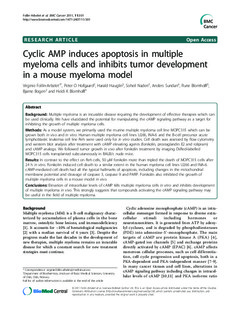| dc.contributor.author | Follin-Arbelet, Virginie | |
| dc.contributor.author | Hofgaard, Peter Olaf | |
| dc.contributor.author | Hauglin, Harald | |
| dc.contributor.author | Naderi, Soheil | |
| dc.contributor.author | Sundan, Anders | |
| dc.contributor.author | Blomhoff, Rune | |
| dc.contributor.author | Bogen, Bjarne | |
| dc.contributor.author | Blomhoff, Heidi Kiil | |
| dc.date.accessioned | 2018-03-26T10:54:34Z | |
| dc.date.available | 2018-03-26T10:54:34Z | |
| dc.date.created | 2011-10-24T15:16:10Z | |
| dc.date.issued | 2011 | |
| dc.identifier.citation | BMC Cancer. 2011, 11:301 | nb_NO |
| dc.identifier.issn | 1471-2407 | |
| dc.identifier.uri | http://hdl.handle.net/11250/2492084 | |
| dc.description.abstract | Background
Multiple myeloma is an incurable disease requiring the development of effective therapies which can be used clinically. We have elucidated the potential for manipulating the cAMP signaling pathway as a target for inhibiting the growth of multiple myeloma cells.
Methods
As a model system, we primarily used the murine multiple myeloma cell line MOPC315 which can be grown both in vivo and in vitro. Human multiple myeloma cell lines U266, INA-6 and the B-cell precursor acute lymphoblastic leukemia cell line Reh were used only for in vitro studies. Cell death was assessed by flow cytometry and western blot analysis after treatment with cAMP elevating agents (forskolin, prostaglandin E2 and rolipram) and cAMP analogs. We followed tumor growth in vivo after forskolin treatment by imaging DsRed-labelled MOPC315 cells transplanted subcutaneously in BALB/c nude mice.
Results
In contrast to the effect on Reh cells, 50 μM forskolin more than tripled the death of MOPC315 cells after 24 h in vitro. Forskolin induced cell death to a similar extent in the human myeloma cell lines U266 and INA-6. cAMP-mediated cell death had all the typical hallmarks of apoptosis, including changes in the mitochondrial membrane potential and cleavage of caspase 3, caspase 9 and PARP. Forskolin also inhibited the growth of multiple myeloma cells in a mouse model in vivo.
Conclusions
Elevation of intracellular levels of cAMP kills multiple myeloma cells in vitro and inhibits development of multiple myeloma in vivo. This strongly suggests that compounds activating the cAMP signaling pathway may be useful in the field of multiple myeloma. | nb_NO |
| dc.language.iso | eng | nb_NO |
| dc.publisher | BioMed Central | nb_NO |
| dc.rights | Navngivelse 4.0 Internasjonal | * |
| dc.rights.uri | http://creativecommons.org/licenses/by/4.0/deed.no | * |
| dc.title | Cyclic AMP induces apoptosis in multiple myeloma cells and inhibits tumor development in a mouse myeloma model | nb_NO |
| dc.type | Journal article | nb_NO |
| dc.type | Peer reviewed | nb_NO |
| dc.description.version | publishedVersion | nb_NO |
| dc.source.pagenumber | 10 | nb_NO |
| dc.source.volume | 11 | nb_NO |
| dc.source.journal | BMC Cancer | nb_NO |
| dc.identifier.doi | 10.1186/1471-2407-11-301 | |
| dc.identifier.cristin | 847549 | |
| dc.relation.project | Norges forskningsråd: 179573 | nb_NO |
| dc.description.localcode | © 2011 Follin-Arbelet et al; licensee BioMed Central Ltd. This is an Open Access article distributed under the terms of the Creative Commons Attribution License (http://creativecommons.org/licenses/by/2.0), which permits unrestricted use, distribution, and reproduction in any medium, provided the original work is properly cited. | nb_NO |
| cristin.unitcode | 194,65,15,0 | |
| cristin.unitname | Institutt for klinisk og molekylær medisin | |
| cristin.ispublished | true | |
| cristin.fulltext | original | |
| cristin.qualitycode | 1 | |

